| Binding | Description | Notes |
|---|---|---|
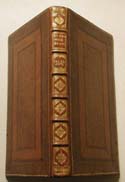 |
Early 18th century, probably 1720’s. Brown leather binding decorated with blind tooling and gilding. The covers are framed by a gold tooled line. | Niels Foss’s library. Niels Foss (1670-1751) was collector of books, landowner, and etatsråd (councillor of state). His library comprised c. 11,500 volumes which were sold at auction after his death. The Royal Library and the University Library (now part of the Royal Library) bought a large part of the collection, but not all of it. Foss had many of his books bound in so-called 'mirror bindings'. This is an 18th century Danish variant of the English Cambridge bindings. The Danish 'mirror bindings' (of which the Royal Library holds a large number) are characterized by a dark marbled central panel (the mirror), surrounded by a blind tooled frame and, outside of that, a lighter area that is also surrounded by a line. The book shown here was bound by Johann Boppenhausen in Copenhagen, who seems to have bound many books for Foss. Saxo Grammaticus: Danica historia libris XVI conscripta (1576). |
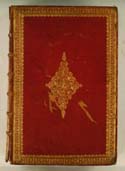 |
Red morocco binding with gold decorations made for Harley (probably Edward H.). See the spine here. |
The Harley library. The Harley collection was founded by Robert Harley (1661-1724) and continued by his son Edward Harley (1689-1741), after whose death the printed books were purchased by the London book dealer Thomas Osborne. The Royal Library holds a considerable amount of Harley books, most of them acquired by Count Otto Thott after whose death they came to the Royal Library. This is one of a number of different types of bindings made for Edward Harley. This book bears another characteristic mark of Harley provenance, viz. Osborne’s price mark. Paulus Aemilius Veronensis: De rebus gestis Francorum libri IX (1517). |
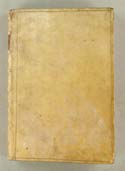 |
Binding of white parchment with gold decorations. The book was in Harley’s possession but the binding was not made for him. See the spine here. |
The Harley library. The Harley collection was founded by Robert Harley (1661-1724) and continued by his son Edward Harley (1689-1741), after whose death the printed books were purchased by the London book dealer Thomas Osborne. The Royal Library holds a considerable amount of Harley books, most of them acquired by Count Otto Thott after whose death they came to the Royal Library. This is one of a number of different types of bindings owned by Edward Harley. This book bears another characteristic mark of Harley provenance, viz. Osborne’s price mark and the cut off top right corner of the first fly leaf (where presumably Harley’s name had been found). Quinte Curse: Contenant les belliqueux faictz d’Armes ... du ... Alexandre le Grand (1530). |
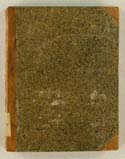 |
Binding of brown stippled paper used for many of the books from J.L. Holstein’s collection. See the spine with Holstein’s coat of arms, the title page, and the colophon. |
J.L. Holstein’s library. Count Johan Ludvig Holstein (1694-1763), Danish politician, collected a library of c. 30,000 volumes (of which 10,000 dissertations) in his castle Ledreborg near Roskilde. Among the many valuable books were almost 2,000 of Luther’s writings (bought at the auction of Bishop Peder Hersleb’s books in 1758) and 670 Bibles (bought at the auction of the theologian J.M. Kraft’s books in 1752). Both the Luther collection and the Bible collection were acquired by the Royal Library in 1812.
XXVII Predig Martin Luthers ... Anno xxiii (1524). |
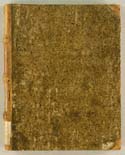 |
Binding of brown stippled paper used for many of the books from J.L. Holstein’s collection. See the spine with Holstein’s coat of arms, the title page, and the colophon. |
J.L. Holstein’s library. Count Johan Ludvig Holstein (1694-1763), Danish politician, collected a library of c. 30,000 volumes (of which 10,000 dissertations) in his castle Ledreborg near Roskilde. Among the many valuable books were almost 2,000 of Luther’s writings (bought at the auction of Bishop Peder Hersleb’s books in 1758) and 670 Bibles (bought at the auction of the theologian J.M. Kraft’s books in 1752). Both the Luther collection and the Bible collection were acquired by the Royal Library in 1812.
Erasmus Sarcerius: Ein warnung büchlein ... (1551). |
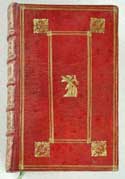 |
Red morocco binding with gold ownership mark on front and back covers. See also Private ownership marks - on the binding. |
Fr. Walter’s library. Frederik Walter (1649-1718), Danish Court official, owned a library which comprised c. 1,000 volumes. The collection was sold at auction in 1719. Today the Royal Library owns about 50 books and 35 manuscripts from Walter’s library, and the manor Overgaard in Jutland owns about 30 volumes. Nouum Testamentum (Græcum), Vol. I (1549). |